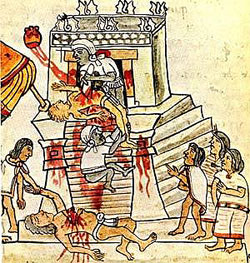Central and South American Indians
By the time Christopher Columbus first laid eyes on the Americas, more than fifty million people lived in North and South America
and about four million lived in what we now know as the United States. The richest, most complex native civilizations developed near the Isthmus of Panama, which divides North and South America. These civilizations were:
Mayas
Web Field Trip
Learn more about the Mayas by reading the travel journals of John Lloyd Stephens who “discovered” the Mayan city of Copán in 1839.
Want to see the Paris Codex online? The Paris Codex is a digital version of a Maya hieroglyphic book. It is only one of four pre-Columbian books that survived the book burnings of the Spanish Conquest.
Mayan culture developed in three regions of Mesoamerica between 300 and 900 AD with the most important development occurring in the central part of southern Guatemala in the tropical rain forest. The Mayas developed a sophisticated approach to astronomy, created a calendar that was more accurate than the one used in Europe, conceptualized a sophisticated mathematical system including a figure to represent zero, and created the most complex system of writing in the Americas. Tikal, one of the largest Mayan Cities in the area, traded with Teotihuacan and had a population of 100,000 at its peak. Because its economy was centered on agriculture, Mayan engineers built canals to water their crops. Numerous Mayan texts exist, containing rich detail about Mayan history, as well as their religious beliefs, which included human sacrifice and self-mutilation. Mayan culture began to decline after the fall of Teotihuacan in 750 AD. By the time the Toltec, a militaristic society, conquered most of Central America and Central Mexico in the 10th century, Mayan urban centers had collapsed and the population dispersed into the surrounding countryside. Today their descendants live in Guatemala, Chiapas, Mexico, the Yucatan Peninsula, and Belize, where they have held tenaciously to their culture and traditions. They continue to speak their languages, wear traditional clothing, follow long established rituals, and incorporate their beliefs into the practice of Christianity.
Aztecs

Aztec human sacrifice, from Codex Magliabechiano
Web Field Trip
Want to learn about the first team sport in History? It was a life and death struggle for the teams and the loser lost their heads—literally! The MesoAmerican Ballgame.
The Aztecs, who called themselves Mexíca, lived in the central part of Mexico in the 14th through 16th centuries, building an extensive empire around their capital of Tenochtitlán, which is now Mexico City. Built on a lake, the only access to Tenochtitlán was by causeway. To help feed the city’s 200,000 inhabitants, the Aztecs built floating gardens, called chinampas, on the lake. The Aztecs established alliances with their neighbors, but eventually Tenochtitlán became the center of power for the region. The Aztecs frequently waged war against their neighbors and took captives to be used for sacrifices in their ceremonies. As in other Mesoamerican cultures, human sacrifice was an important part of Aztec society. The Aztecs, however, practiced it with an intensity not held by anyone else in the Americas. At the dedication of the Great Pyramid of the Sun in 1487, Aztec priests sacrificed more than 84,000 prisoners (according to some sources) in a ceremony that lasted four days. For the sacrifice, the captive climbed the steps of the pyramid and was held by force on a sacrificial slab while a priest sliced opened his chest and ripped out his heart. The priest then held the heart up to the sun before placing it inside a statue of their god. The lifeless body of the captive was rolled down the steps so that the captor’s family could eat parts of the body. The captor himself did not eat the body; instead he fasted and mourned the death of his foe. Though violent, Aztec society was highly advanced in the arts, especially in song and poetry. Additionally, the Aztecs built an elaborate system of roads to facilitate trade and communications between its conquered territories. The Aztecs were also one of the few groups in the world to institute mandatory education for all children. The Spanish conquered the Aztecs in 1519 when the Aztec king, Montezuma, surrendered to Hernando Cortés.
Incas
Web Field Trip
Learn about the recovery of the largest cache of Incan mummies discovered from a single time period in this National Geographic Article.
Also called the Quechua people, the Incas inhabited the Andes Mountains. At its peak, the Incan empire extended some 2,000 miles, and included as many as 12 million people. Subjects of the empire were required to pay tribute, which the Incas measured using a device called a quipu. The quipu, made of thread or animal hair, used a series of knots to calculate or record totals. The Incas linked their vast empire together through a series of roads and suspension bridges. To facilitate trade, the Incas built grain storehouses along the roads. While the Incas practiced many forms of artistic expression, including pottery and textiles, their most impressive achievements were in the area of architecture, especially in their ability to build cities high in the Andes. Using a method of construction that tightly locked large stones together, Inca engineers constructed structures capable of withstanding earthquakes. The Incas also made numerous discoveries in the area of medicine and even performed skull surgery. View the following interactive for additional information on Aztec, Mayan, and Incan culture.